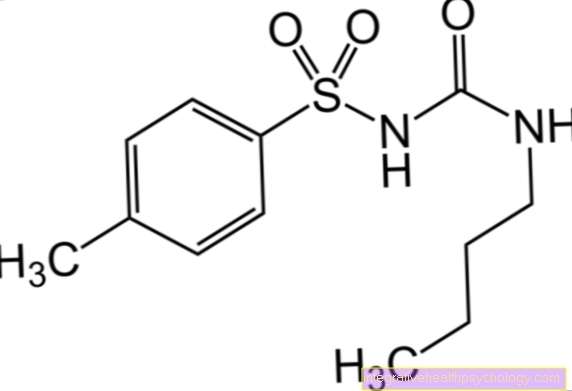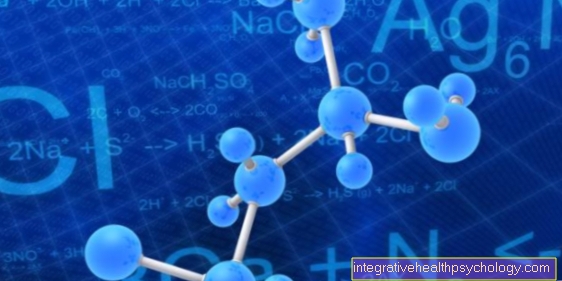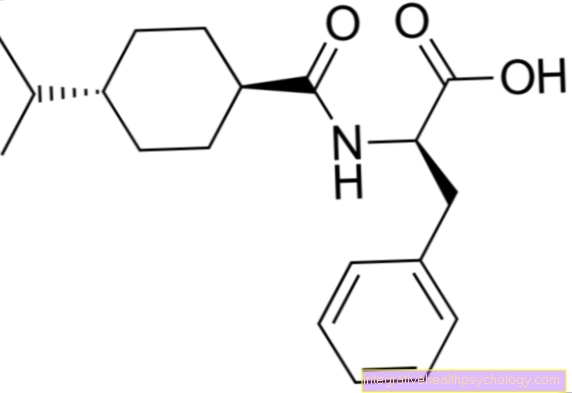Lactate
Synonyms in the broadest sense
Lactic acid, lactic acid salt, hydroxy acid, lactate concentration
introduction
Lactate is the end product of the anaerobic oxidative (using oxygen) Metabolism. This leads to an oxidation of the grape sugar (glucose).
This form of energy supply occurs in sports training when the energy requirement is greater than the energy supply, and mostly occurs in the striated muscles. This anaerobic, lactic energy deficit occurs particularly at the beginning of sporting activities and with longer sprint loads in speed training (400m, 800m) in front. Therefore, these forms of stress are considered very uncomfortable. While the lactate level in the blood rises, the H + ion concentration rises, and this leads to acidosis.

Lactate in the blood
Lactate is mainly and in large quantities during athletic stress out Muscle cells released. But it can also be done in other ways - such as with Oxygen deficiency or one infection - ins blood reach. Of the Lactate breakdown no longer happens directly in the muscle, but in other organs (Liver, kidney, heart).
That which can be determined in the blood Lactate level is the result of a constant new formation and the continuous breakdown of lactate. This blood lactate level depends on the degree of sporting activity, but also on the level of training and the nutrition, Alcohol consumption, certain drugs (for example Metformin at Diabetes mellitus) or general diseases that are associated with an insufficient supply of oxygen, in which the purely aerobic metabolism is no longer possible after a short time.
Almost everyone pathological condition, due to which the amount of oxygen required in the tissue is too low, the lactate production is too high or the lactate breakdown is too low, consequently leads to an increased incidence of Lactic acid salt. In most cases, a combination of all of these factors can be assumed.
If too much lactate collects in the blood, it is initially referred to as one Hyperlactataemia, which by a slightly exceeding the standard value is marked and one compensation the condition of over-acidification (for example through increased To breathe) is still possible.
If the level continues to rise subsequently, it ultimately comes to Lactic acidosiswhich with severe decrease in the pH value of the blood (normal blood pH = 7.4) and such a strong increase in lactate concentration that the Compensation mechanisms of the organism no longer sufficient are.
In addition, it can also occur during or shortly after a surgical procedure and in patients in the State of shock (Circulatory failure of various origins) lead to increased values. Therefore, lactate diagnostics is a standard procedure of every medical laboratory and additional to the benefit in terms of Control of the training condition of an athlete also for diagnosis and prognostic purposes Assessment of shock patients and much more extremely relevant.
Steady state

The constant build-up and breakdown of lactate usually results in a certain level of stress in the body balance a: By simultaneous lactate formation and utilization creates a state in which net no lactate production is to be expected. One speaks of one Steady state, the so-called "Steady state“(English permanent state). This term is mainly used in chemistry and also in biochemistry and only describes the fact that the formation and breakdown of certain substances in the body is not a single isolated process, but rather a "flow" can be observed. Individual reactions are dependent on one another and are precisely tailored to one another. Lactate is produced, enters blood over and is quickly taken from there for dismantling. If more lactate is produced, the blood lactate level will initially rise slightly, while more lactate will then be broken down again. Many other reactions and metabolic pathways in the body also work according to this principle.
For sports medical examinations or the individual performance measurement and control that is possible via the lactate level is that Lactate steady state of great importance. So is the common Stress tests (e.g. on a bicycle ergometer) gradually increases the physical strain on the patient / test person after a certain period of time. In the case of the bicycle ergometer, this load can be regulated via the resistance. As a result, the lactate level in the blood rises measurably because the Muscles need more energy for increased work performance. Briefly is so a relatively high amount of lactate can be determined. After a while, this level of stress levels off again a balance (= new steady state). The lactate levels in the test person's blood would no longer change. This principle is followed until the steady state is no longer established, because the body can no longer compensate for the significantly increased load. It comes to one continuous increase in lactate, which ultimately also the entering Exhaustion conditional and lets the test subject finish the test.
Such a lactate level test is especially useful for top athletes as well Endurance athlete extremely common at competition level for training optimization. Classically he is at marathon- and half marathon runners, Triathletes as well as cyclists.
Lactate levels
The concentration of the Lactate is approx. 1mmol / liter. That is measured Lactate concentration in the blood, usually on the earlobe. With slow athletic exertion the lactate value is approx. 2mmol / liter. One speaks of one aerobic threshold. During this phase, the lactate produced is sufficiently eliminated. If the value of the resulting lactate corresponds to that of the lactate elimination, one speaks of a Lactate steady state. This at about 2-4 mmol / liter undc will also aerobic-anaerobic transition called. The anaerobic threshold is around 4mmol / liter. If this value occurs during sporting activities, one speaks of a anaerobic (without consumption of oxygen) metabolism. Lactate levels of up to 25mmol / liter were measured in top athletes. The pH value was about 7 in the blood (usually 7.4).
Reduce lactate levels in sports
Simple recommendations and measures hardly influence lactate levels. For example, diet has almost no lowering effect on the lactate level in the blood. Although one can Thiamine deficiency (Vitamin B1) increase the lactate level in the blood, but the reverse is that especially a lot Vitamin B1 Lactate-reducing effect does not apply. However, such measures are usually not necessary.
Of the Training condition however, it can affect how much oxygen at rest but also under sportive stress transported to the muscles becomes, in which in the course of the remodeling measures in the body after training lots of new blood vesselsthat lead to the muscles form (increased capillarization). In addition, over a longer period of time with regular training, the point at which the anaerobic metabolism must start and support aerobic energy production can be shifted; that is, the exact location of the anaerobic threshold is individually different and can be influenced.If the anaerobic threshold changes measurably, one speaks of one Training adjustment of the anaerobic threshold.
On the other hand, of course, that also means that Sedentary lifestyle - Both lighter forms and, for example, complete immobility for several years as a result of chronic diseases - the lowers anaerobic threshold and the general lactate tolerance of the body reduced.
If the term “training” is used in the preceding or in the following, it is always used moderate endurance training meant, which is particularly crucial for the lactate metabolism.
Physiologically, the lactate decreases after a certain period of time in certain organs (Liver, kidney, heart) oxidatively degraded (Elimination of lactate). These processes already begin during exercise. It will Lactate to pyruvate oxidized. The resulting pyruvate is then fed back into the oxidative (= aerobic) metabolism and thus provides energy again. Both the Heart- as well as the skeletal muscles can then use them in the further course. Ultimately, if there is an enormous excess of energy in the liver, lactate can be converted back into sugar (glucose) via a few intermediate steps (intermediate product for example pyruvate), which is then stored or further processed.
The most effective and cost effective treatment option for a acute lactic acidosis is regeneration. With Rest breaks Without straining the muscles, the body can regain its natural balance after intense exertion and gradually reduce the excess lactate.
Summary
The increase in the lactate concentration in the blood depends on the current stress / strain and is a decisive criterion in endurance performance diagnostics. In modern competitive sport, the measurement of lactate is indispensable, and such tests are increasingly finding their way into recreational sports in the field of Marathon preparation etc. Lactate is measured in the so-called lactate level test, in which the load is continuously increased.





























